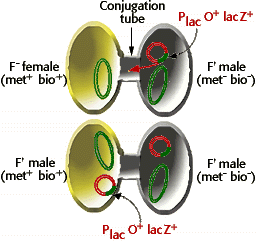
Molecular Genetics of Prokaryotes Problem Set
Problem 5: DNA transfer by an F factor
Tutorial to help answer the question
An E. coli strain is F lac Z lac Z met met bio bio . Cells from this strain are mixed with an E. coli strain that is lac Z . Cells from this strain are mixed with an E. coli strain that is lac Z met met bio bio and carrying an F' episome with the Plac O and carrying an F' episome with the Plac O lac Z lac Z DNA sequence on the episome, and cultured for several hours. Then cells were removed, washed, and transferred to minimal media containing lactose as the only sugar source. A few cells were able to grow on minimal media with lactose, and formed colonies. How did these few cells become lac Z DNA sequence on the episome, and cultured for several hours. Then cells were removed, washed, and transferred to minimal media containing lactose as the only sugar source. A few cells were able to grow on minimal media with lactose, and formed colonies. How did these few cells become lac Z met met bio bio ? ?
|
Tutorial
Conjugation
|
From question 4, we learned that E. coli bacteria can sexually conjugate and exchange genetic information. The genes that are required for conjugation, including the components of the pili on the surface of the male bacterium and the conjugation tube used for one-directional transfer of a copy of male DNA to the female cell, are encoded on the F' factor DNA of the male bacterium.
|
University of Arizona
Updated: July 15, 1999
Contact the Development Team
http://www.biology.arizona.edu
All contents copyright © 1998-99. All rights reserved.







